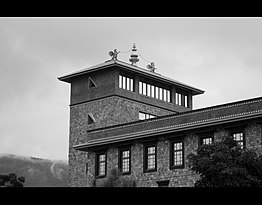
Back سونغتسين غامبو Arabic Сонгцен Гампо Bulgarian স্রোং-ব্ত্সন-স্গাম-পো Bengali/Bangla སྲོང་བཙན་སྒམ་པོ། Tibetan Songtsen Gampo Catalan Songcän Gampo Czech Songtsen Gampo German Σονγκτσάν Γκάμπο Greek Songtsen Gampo Spanish Songtsen Gampo Estonian
| Songtsen Gampo སྲོང་བཙན་སྒམ་པོ | |||||||||
|---|---|---|---|---|---|---|---|---|---|
| Tsenpo | |||||||||
 Statue of King Songtsen Gampo on horseback in front of the Songtsen Library in Dehradun, India | |||||||||
| 33rd King of Tibetan Empire | |||||||||
| Reign | c. 618 – 650 | ||||||||
| Predecessor | Namri Songtsen | ||||||||
| Successor | Gungsong Gungtsen or Mangsong Mangtsen | ||||||||
| Born | Songtsen c. 557 to 569 approximately Maizhokunggar, Tibet | ||||||||
| Died | 649 (aged 79-92 years) approximately Zelmogang, Penyül, Tibet (in modern Lhünzhub County) | ||||||||
| Burial | 651 Muri Mukpo Mausoleum, Valley of the Kings | ||||||||
| Wives | Belmoza Tritsün (aka Bhrikuti, from Nepal) Gyamoza Münchang (aka Princess Wencheng, from Tang China) Minyakza Gyelmotsün (from Tangut) Litikmen (from Zhangzhung) Mongza Tricham | ||||||||
| Children | Gungsong Gungtsen | ||||||||
| |||||||||
| Tibetan | |||||||||
| Wylie transliteration | Srong-btsan sGam-po | ||||||||
| THL | Songtsen Gampo | ||||||||
| Lönchen | |||||||||
| House | Yarlung dynasty | ||||||||
| Father | Era of Fragmentation Namri Songtsen | ||||||||
| Mother | Driza Thökar | ||||||||
| Religion | Tibetan Buddhism | ||||||||
| Part of a series on |
| Tibetan Buddhism |
|---|
 |
Songtsen Gampo[1] (Classical Tibetan: [sroŋpʦan zɡampo], pronounced [sɔ́ŋʦɛ̃ ɡʌ̀mpo]) (Tibetan: སྲོང་བཙན་སྒམ་པོ, Wylie: srong btsan sgam po, ZYPY: Songzän Gambo; 569–649/650), also Songzan Ganbu (Chinese: 松贊干布; pinyin: Sōngzàn Gānbù), was the 33rd Tibetan king of the Yarlung dynasty and he established the Tibetan Empire.[a] As the first of three Dharma Kings of Tibet, he formally introduced Buddhism to Tibet, and built the Jokhang with the influence of his Nepali queen Bhrikuti, of Nepal's Licchavi dynasty. He unified several Tibetan kingdoms,[2] conquored lands adjacent to Tibet, and moved the capitol to the Red Fort in Lhasa.[3] His minister Thonmi Sambhota created the Tibetan script and Classical Tibetan, the first literary and spoken language of Tibet.[3]
His mother, the queen, is identified as Driza Thökar (Tibetan: འབྲི་བཟའ་ཐོད་དཀར་, Wylie: 'bri bza' thod dkar, ZYPY: Zhisa Tögar).[4] The exact date of his birth and his enthronement are not certain, and in Tibetan accounts it is generally accepted that he was born in an Ox year of the Tibetan calendar.[5] He ascended the throne at age thirteen, circa 618.[2][6]
There are difficulties with the ascension dates, and several earlier dates for the birth of Songtsen Gampo have been suggested, including 569, 593 or 605.[7]

- ^ Powers, John (2016). The Buddha party : how the people's Republic of China works to define and control Tibetan Buddhism. New York: Oxford University Press. pp. Appendix B, Page 16. ISBN 9780199358151. OCLC 947145370.
- ^ a b Shakabpa 1967, p. 25.
- ^ a b Claude Arpi, Glimpse of Tibetan History, Dharamsala: Tibetan Museum
- ^ "སྲོང་བཙན་སྒམ་པོ།". 中国·西藏藏语言文字网. Retrieved 9 April 2022.
- ^ bsod nams rgyal mtshan 1994, pp. 161, b.449, 191 n.560.
- ^ Beckwith 1993, p. 19 n. 31..
- ^ Yeshe De Project 1986, pp. 222–225.
Cite error: There are <ref group=lower-alpha> tags or {{efn}} templates on this page, but the references will not show without a {{reflist|group=lower-alpha}} template or {{notelist}} template (see the help page).
© MMXXIII Rich X Search. We shall prevail. All rights reserved. Rich X Search